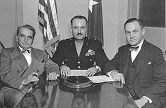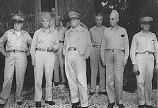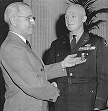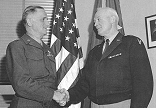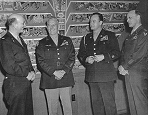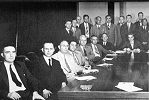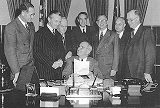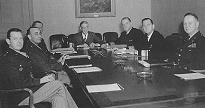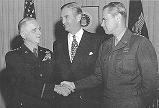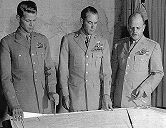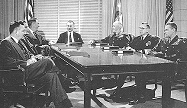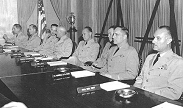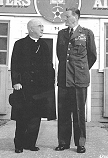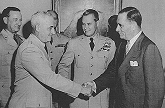Group Photos Section: Suspected Majestic Personnel
This section consists of a series of photographs and explanations that suggest links to MJ-12 personnel. The military photographs are from the National Archives and show in some cases—such as the photo at the left—clear and proud associations of known MJ-12 members, in this case, Dr. Theodore Von Karman, General Donald Putt and Dr. Robert E. Lombard.
Group Photos
Click on photos to view larger versions.
General Douglas MacArthur, Commander-in-Chief of the Allied Forces in the Southwest Pacific Area, photographed with some of his landing officers on an island in the Southwest Pacific during the General’s visit to American troops, who immediately afterward made their first landing on New Britain, Major Japanese base. Left to right: Major General S. J. Chamberlin, General MacArthur’s Operations Officer, Lt. General Walter Kreueger, Commander of the American Sixth Army; General MacArthur; Brig. General E. D. Patrick, Chief of Staff of the Sixth Army; Vice-Admiral Thomas C. Kinkaid, Commander of the Allied Naval Forces; and Major General Ennis R. Whitehead, Deputy Commander of the Fifth Air Force. Chamberlin later rose to become the Assistant Chief of Staff, G-2 (Intelligence) in the summer of 1947 and was one of the members of the summer “Mission” resulting in the report on recovered lenticular aerodyne objects of September 1947.
(Left to right) Col. C. R. Glenn, chief surgeon of Air Materiel Command, Maj. Gen. Malcolm G. Grow, Air Surgeon of the AAF, Brig. Gen Wallace Graham, personal physician to President Truman, and Col. E. J. Kendricks, chief of the aero-medical laboratory at Wright Field, gather for a brief chat during a break in sessions of the first Flight Surgeon’s school which opened at Wright Field on April 7, 1947. Had any of these men performed autopsies on aliens from the crashes of 1941 or May 1947? Malcolm Grow in the author of reports on air accidents during the summer of 1947.
Joint Research and Development Board Meeting, 11 February 1948. Seated left to right are: Major General L. C. Craigie, General Joseph T. McNarney, General Jacob L. Devers, Dr. Vannevar Bush, Chairman of Joint Research and Development Board, Vice Admiral E. W. Mills, Vice Admiral J. D. Price and Lt. General H. S. Arnold. The JRDB implemented the funding for new developments based on new science. In those days, the view was that scientific breakthroughs could make a quick military difference as evidenced by our atomic bomb example.
Taken 2 April 1948 by James Evans, Air Force photographer. General Spaatz turning over the Air Force responsibilities to General Hoyt Vandenberg (right), with Secretary of the Air Force Symington looking on approvingly. Vandenberg was the one who is reported to have “killed” the extraterrestrial explanation for flying saucers.
Secretary of Defense James Forrestal’s last meeting, 25 March 1949. Among those present were: Under Secretary of Navy, W. J. Kenney; Secretary of AF, W. Stuart Symington; Secretary of Army, Kenneth C. Royall; Mr. James Forrestal; General Omar Bradley; Admiral Louis Denfield and General Hoyt S. Vandenberg. Shortly after this photograph Forrestal resigned, and two months later he was murdered, according the one of our documents (Fragment of Annex C).
Dr. Theodore von Karman, Brigadier General Donald L. Putt, and Dr. Albert E. Lombard, Jr., three of the U. S. Air Forces top scientific personnel. Dr. von Karman was chairman of the Scientific Advisory Group, and organization which coordinates the latest scientific thinking with USAF operational planning. General Putt was Director of USAF Research and Development in the Office of the Deputy Chief of Staff, Material, in Headquarters, USAF, and Dr. Lombard is head of the Research Division under General Putt. Al Lombard went on to become the head of McDonnell Aircraft Company research laboratories and was a personal acquaintance of Dr. Robert M. Wood.
General Staff Meeting at Washington, D. C., 20 August 1951, (left to right) Gen. Emery S. Wetzel, Lt. Gen. Chas. B. Stone, Lt. Gen Thos. D. White, Gen. Nathan F. Twining, Gen. Hoyt S. Vandenberg, Gen. Howard A. Craig, Lt. Gen. Orval R. Cook and Maj. Gen. Donald L. Putt. This is the group of men who established and implemented Air Force Policy.
Air power and prayer power were the topics of conversation as His Eminence Francis Cardinal Spellman conferred with Maj. Gen. Ralph F. Stearley outside the Okinawa headquarters of the Twentieth Air Force. Military vicar for the armed forces, Cardinal Spellman spent a day talking with combat personnel throughout the island. January 1952. Three of our documents allude to interaction with Spellman. It is certainly reasonable that he would have been “called” to comment on any ET remains. However, references to him do not prove that such an event happened.
General Nathan F. Twining, left, is congratulated by Hon. Harold E. Talbott (right), Secretary of the Air Force, after being sworn as Air Force Chief of Staff. Looking on are, left to right: General Thomas D. White, Vice Chief of Staff, U. S. Air Force; Colonel K. E. Thiebaud, Air Adjutant General and General Hoyt S. Vandenberg, retiring Chief of Staff. General Twining was sworn in during ceremonies at the Pentagon following the retiring ceremonies for General Vandenberg at Bolling Air Force Base, Washington, DC, 1 July 1953. It is interesting that the reins of leadership were passed to a General who was apparently involved in the UFO crash recoveries.
